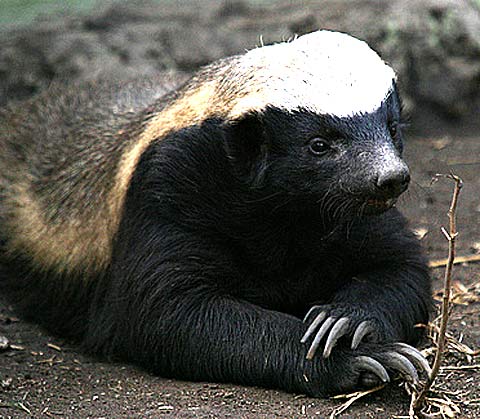Welcome to DU!
The truly grassroots left-of-center political community where regular people, not algorithms, drive the discussions and set the standards.
Join the community:
Create a free account
Support DU (and get rid of ads!):
Become a Star Member
Latest Breaking News
General Discussion
The DU Lounge
All Forums
Issue Forums
Culture Forums
Alliance Forums
Region Forums
Support Forums
Help & Search
Science
Related: About this forumWhy the honey badger doesn't care about cobra venom.
It’s official: Honey badger don’t care. This “crazy nasty-ass” critter—the subject of a National Geographic documentary transformed into a viral meme through satirical overdubbing—“really don’t give a shit.” Not about snarky documentaries, not about stinging bees, and especially not about venomous snakes.
Venomous snakes kill up to 94,000 people every year, on top of the millions of other animals that make up their diet. And death by venomous snakebite isn’t pretty: The toxins in venom can paralyze muscles, break down tissue, and even make victims bleed uncontrollably.
So why don’t honey badgers care about venoms that can kill almost any other animal?
Danielle Drabeck, a University of Minnesota grad student, wanted to study this question on a molecular level, but she ran into a problem: Honey badgers aren't found in Minnesota or even the Western Hemisphere, but only in Africa, the Middle East, and India.
Venomous snakes kill up to 94,000 people every year, on top of the millions of other animals that make up their diet. And death by venomous snakebite isn’t pretty: The toxins in venom can paralyze muscles, break down tissue, and even make victims bleed uncontrollably.
So why don’t honey badgers care about venoms that can kill almost any other animal?
Danielle Drabeck, a University of Minnesota grad student, wanted to study this question on a molecular level, but she ran into a problem: Honey badgers aren't found in Minnesota or even the Western Hemisphere, but only in Africa, the Middle East, and India.
Biology Finally Explains Why Honey Badger Don’t Care
My boys love that "Honey Badger Doesn't Give A Shit" video, and I came across it, and wondered how they got away with eating cobras. It appears that they, mongooses, and surprisingly pigs, all have mutations in the protein binding site in the cobra neurotoxin receptor.
<iframe width="640" height="360" src="" frameborder="0" allowfullscreen></iframe>
InfoView thread info, including edit history
TrashPut this thread in your Trash Can (My DU » Trash Can)
BookmarkAdd this thread to your Bookmarks (My DU » Bookmarks)
7 replies, 2550 views
ShareGet links to this post and/or share on social media
AlertAlert this post for a rule violation
PowersThere are no powers you can use on this post
EditCannot edit other people's posts
ReplyReply to this post
EditCannot edit other people's posts
Rec (11)
ReplyReply to this post
7 replies
 = new reply since forum marked as read
Highlight:
NoneDon't highlight anything
5 newestHighlight 5 most recent replies
= new reply since forum marked as read
Highlight:
NoneDon't highlight anything
5 newestHighlight 5 most recent replies
Why the honey badger doesn't care about cobra venom. (Original Post)
NNadir
Aug 2016
OP
yuiyoshida
(41,831 posts)1. RANDALL
Judi Lynn
(160,527 posts)3. Wow. Never knew about Randall! Thanks for the video.
[center]  [/center]
[/center]
vlakitti
(401 posts)2. What Darwin said about
natural selection. Very effective.
NNadir
(33,516 posts)4. This is what graduate student Danielle Drabeck's research is all about.
She seems to be a fine young scientist who is very involved in positive ways beyond turning out a Ph.D.
DANIELLE H. DRABECK, outreach
It's people like her on whom the future will depend. I wish her well, a less than bleak life.
Wilms
(26,795 posts)5. Just noticed your sig line.
Brother Buzz
(36,423 posts)6. I always enjoyed the persistent honey badger in The Gods Must Be Crazy II
NNadir
(33,516 posts)7. I just accessed Ms. Drabeck's paper entitled "Why the honey badger don't care: Convergent...
...evolution of venom-targeted nicotinic acetylcholine receptors in mammals that survive venomous snake bites.
Here is a link to the publication if you have access: Toxicon Volume 99, 1 June 2015, Pages 68–72
It appears that the Nicotinic Acetylcholine Receptor (nAChR) a protein, has two polymorphisms. From the text:
Our results extend the known cases of convergent evolution at venom-targeted nAChR receptors to include the honey badger and domestic pig. The honey badger and pig lineages independently acquired replacements that are biochemically similar to those seen in the hedgehog: W187R (all three species) and F189L, (L in honey badger and pig; I in hedgehog). In mongoose, substitutions at these same sites also occur, but they eliminate ?-neurotoxin binding through steric hindrance via glycosylation rather than charge interference via introduction of a positively charged amino acid. Hence, evolution of resistance in venom-targeted nAChR receptors shows that convergence in function at the same sites can be mediated through distinct biophysical mechanisms.
W187R means that that tryptophan at position 187 in the protein sequence is substituted with arginine in the honey badger and domestic pig, and that in position 189, phenylalanine is substituted with leucine in the honey badger and pig, and isoleucine in the hedgehog.
The central dogma of biology whereby the protein sequence corresponds to a genetic mutation is also discussed in the paper.
I hope the reader will find this interesting.